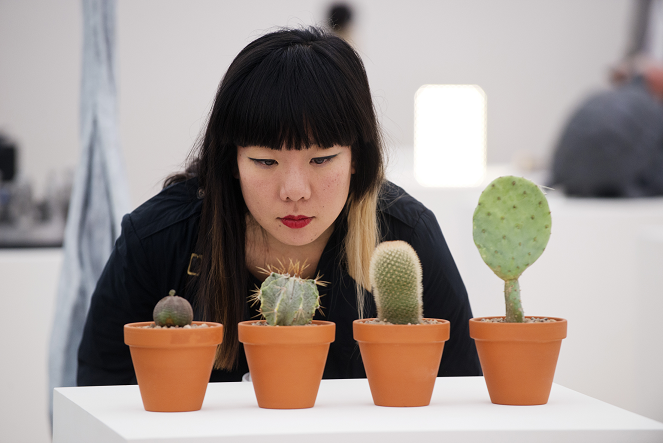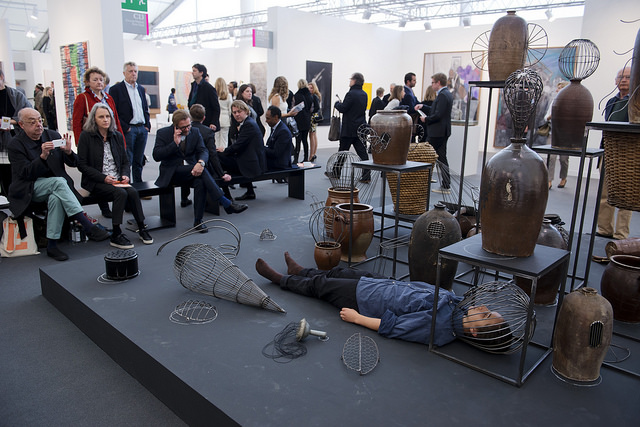
Hauser & Wirth, Frieze London 2015
Photo: Linda Nylind. Courtesy of Linda Nylind/Frieze
How to… make the most of an art fair
How much attention should you pay to the food at an art fair? And can you ask how much the art costs? Oonagh Murphy offers strong pre-visit advice.
Art fairs are strange things – part commercial gallery, part celebrity-fuelled media circus, part business, part shopping mall. Art fairs are also extremely diverse, from the high-end Frieze art fair and Frieze Masters to smaller and lower budget fairs such as the Affordable Art Fair.
Despite the diversity of art fairs there are a few common pieces of advice I gave to any aspiring galleriest when visiting their first art fair.
What you need to know
Art fairs are high-stake, big-business ventures. Galleries pay exuberant amounts of money to exhibit, so remember that their first priority will always be collectors and buyers. If you want to chat with a gallery pick your moment carefully, and only approach if their stand is quiet. Many of the key international galleries bring in their best sales people for events such as Frieze, so don’t be put off if they don’t have time to talk to you. Instead, take a step back, appreciate their priorities and observe how they operate from a safe distance.
Art fairs are an incredible snapshot of artistic practice at a moment in time: when else can you see work from artists in South America, Africa, Asia and Europe, and in the case of contemporary fairs like Frieze, work that is fresh from the artist’s studio and exhibited publically for the first time? I vividly remember the buzz around the Chapman Brothers drawing on bank notes on the opening day of the 2007 Frieze art fair, and at last year’s fair artist Ken Kagami drew me and other visitors naked. (We kept our clothes on but he drew what he imagined we looked like naked.)
Art fairs are bizarre, but they are also exciting: they represent the zeitgeist from the height of the market to the 2008 crash. Like the galleries themselves, art fairs represent much more than simply the art they show. At Frieze London this year, Martin Soto Climent has transformed the entrance to the fair with an installation, which will be animated by acrobats, while Julie Verhoeven is staging a performative intervention in a toilet cubicle.
What you can learn about galleries
Behind the shiny veneer, galleries are like any workplace. They have clients, they have product (artists), and they have internal politics. This is all put out on display at an art fair. Research galleries in advance of your visit and then spend some time observing the type of clients they attract, observe the dress code of employees, observe how employees interact with each other.
Some galleries are fierce and contemporary, with staff dressed in head-to-toe designer (or Cos for the less important fair days), and they deal in the most high-profile artists of the day. Other galleries may focus on developing young artists and developing their market profile and value, or on art from a specific region. The artists a gallery represents, the clients it works with, and the dress code and attitude of staff says a lot about what it would be like to work with that gallery.

How to network
Bring your notebook and take notes on galleries, on artists, and on how the stand has been curated. Look at the type of work on display. Look at which artists are represented by which gallery. These are all excellent things to know when you go for an interview at a gallery: they show that you have a really in-depth knowledge of that particular gallery’s business model.
Never ask how much a work of art is; that’s generally a no-no at Frieze and many other fairs. At fairs where the prices are less confidential, such as the Affordable Art Fair, the price is displayed next to each work.
Whilst gallery staff are hard at work and probably not interested in networking with anyone not looking to buy, art fairs provide lots of great opportunities for networking in other ways. Many now have an extensive talks programme. Attend, chat to the people beside you, ask questions, have a chat with the guest speaker after their talk. Chat to fair staff, because those on temporary contracts are often in a similar position to you, all in search of their dream job in the art world. Chat to the ticket staff, the cloakroom staff, and the front of house staff, ask them what it’s like to work at the fair – they will have all the juicy gossip about what the art world is ‘really’ like.
Also be sure to check out what other businesses are represented at the fair, for example many have a publications section with staff from art magazines and book publishers showing their wares, more great people to chat to and network with.
What to see
See everything! I always advise my students to really look behind the glamour of art fairs to truly understand the operations, management and marketing of these large-scale cultural events. Check out the food offering. How is it priced? How has it been ‘curated’? What are the temporary staff wearing? Are they friendly? How is the visitor experience? What are the bathrooms like? Did you have to queue for long to get in? Is it too hot? Is it too cold? Are the bins overflowing? Is it crowded? What is the lighting like? Are there places to sit down? Have the carpets been laid correctly? Are the walls in the gallery stands painted well?
These might seem like trivial questions, but if you want an audience to focus on the art then these are all crucial, often unnoticed questions, that fair directors spend all year trying to find a solution to. Appreciate the art, but if you are interested in a career working at an art fair, then also be sure to appreciate the signage and the carpets.
Work at a fair
Many art fairs take on temporary staff for the duration of the fair in a variety of roles, from VIP assistants to press assistants, front of house staff, technicians and office staff. These roles, unlike many junior roles in the arts, are actually paid.
I worked as an Assistant to the Fair Manager at the Frieze Art Fair (think glorified PA) for four consecutive fairs. It was a high-pressure job, with long hours and lots of standing, but it was a money-can’t-buy glimpse into the height of the commercial art world. From dealing with stressed gallery directors, super models’ dogs, and the whims of artists – it really was a crash course into the art world and celebrity culture.
I learnt a lot about what roles are available in the art world, which galleries are lovely, and which galleries are so highly strung that the idea of working for them still fills me with dread. There are really useful things to know when thinking about which galleries you would like to work for long term.
Oonagh Murphy is Associate Professor of Visual Arts Management and Curating at Richmond University, London.
www.oonaghmurphy.com
Upcoming Fairs
- Frieze London, Regent’s Park, London, 6 – 9 October 2016
- Frieze Masters, Regent’s Park, London, 6 – 9 October 2016
- The Other Art Fair, Old Truman Brewery, 6 – 9 October
- Affordable Art Fair, Battersea Park, London, 20 – 23 October 2016
- London Art Fair, Business Design Centre, London, 18 – 22 January 2017
Inset photo: Eva Koťátková, Meyer Riegger, Live section, Frieze London 2015. Photograph by Linda Nylind. Courtesy of Linda Nylind/Frieze.
Join the Discussion
You must be logged in to post a comment.